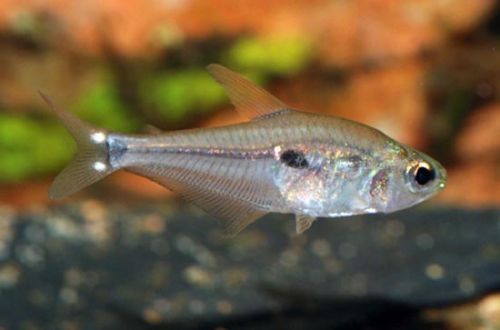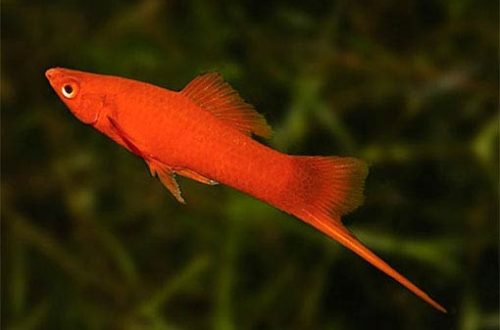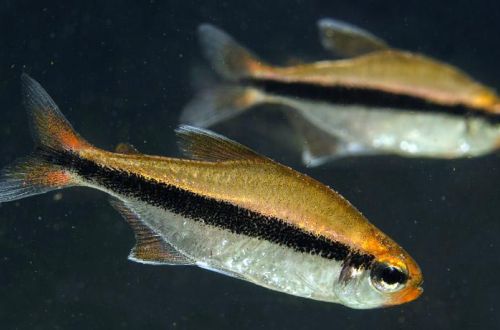
Peruvian Tetra
The Peruvian Tetra or Peruvian Neon, scientific name Hyphessobrycon peruvianus, belongs to the Characidae family. It is widely distributed in the aquarium trade due to its relative unpretentiousness, ease of maintenance and breeding, as well as its peaceful disposition and excellent compatibility with other species. All this has made him a frequent visitor to home freshwater aquariums.

Contents
Habitat
It comes from the upper Amazon basin in what is now Peru (South America). Found in shallow shallow tributaries of larger rivers. The habitat is characterized by dense coastal vegetation hanging over the water with numerous snags and fallen leaves at the bottom. Due to the abundance of organic matter, the water is colored light brown.
Brief information:
- The volume of the aquarium – from 60 liters.
- Temperature – 22-27°C
- Value pH — 5.0–7.0
- Water hardness – soft (2-10 dGH)
- Substrate type – any sandy
- Lighting – subdued
- Brackish water – no
- Water movement is weak
- The size of the fish is up to 4 cm.
- Food – any food
- Temperament – peaceful
- Keeping in a flock of at least 6-10 individuals
Description
Adult individuals reach a length of up to 4 cm. The color of the body is silvery with a blue tint, a wide black stripe stretches below the midline from head to tail. The dorsal and anal fins are pointed, the tail is forked. Sexual dimorphism is weakly expressed, it is rather difficult to distinguish a male from a female.
Food
Accepts all types of dry, frozen and live food. It is recommended to combine a variety of foods in the daily diet, for example, flakes and granules with bloodworms or daphnia. Such a menu helps to increase the brightness of the color.
Maintenance and care, arrangement of the aquarium
A small flock of Peruvian Tetras will thrive in a tank from 60 liters, which is designed using a sandy substrate, snag shelters and areas of dense vegetation. Fish prefer subdued light, so choose shade-loving plants such as Anubias, Cryptocryne, or mosses.
Water conditions have mild pH values with low carbonate hardness. To give the water a characteristic light brown hue and saturate it with tannins, a filter with peat-based filter material is usually used and / or a rag bag filled with peat is added to the water. Peat is purchased exclusively in pet stores, already prepared for use in aquariums, and in no case should you take it from natural reservoirs.
In maintenance, the main task is to ensure high water quality, prevent the accumulation of organic waste (food leftovers, excrement). In a timely manner, once a week, replace part of the water (15-20% of the volume) with fresh water, if possible, install a productive filtration system.
Behavior and Compatibility
Peaceful friendly species, characterized by high mobility, so it can cause inconvenience to slow fish. Otherwise, it goes well with other species of similar size and temperament. Contained in a flock of at least 8-10 individuals.
Reproduction / breeding
They belong to spawning species, females spawn in open water, and males at this moment fertilize it. Parental instincts are not developed, so immediately after spawning, the fish can eat their future offspring.
Easy to breed, fry can appear in the general aquarium, but the survival rate in this will be at an extremely low level. If you plan to start breeding the Peruvian Tetra, then you will need to purchase a separate tank of about 20 liters, in which spawning will actually take place.
The spawning aquarium is filled with water from the main tank, a heater and a simple foam airlift filter are used from the equipment. Separate lighting is not required, the light coming from the room is enough. The design is the simplest, you can not use anything at all. In order to protect the caviar from being eaten, the bottom is covered with a layer of glass beads or a fine mesh is placed.
Mating season can begin at any time throughout the year, but it has been noted that a neutral pH at around 27°C can be stimulated, with a daily diet consisting predominantly of live foods.
When the females are noticeably rounded, they are placed in the company of several of the strongest males in a spawning aquarium. At the end of the action, and this may not happen immediately, but after a few days, the fish are returned back. Feed the fry with specialized food for juvenile aquarium fish.
Fish diseases
A balanced aquarium system with suitable conditions is the best guarantee against the occurrence of any diseases, therefore, if the fish has changed its behavior, color, uncharacteristic spots, etc., check the water parameters first, and only then proceed to treatment.





